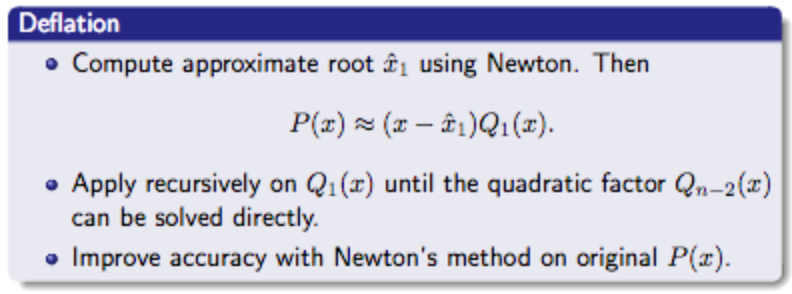Algebraic Polynomials
-
Fundamental Theorem of Algebra:

-
Existance of Roots:

-
Polynomial Equivalence:

This result implies that to show that two polynomials of degree less than or equal to \(n\) are the same, we only need to show that they agree at \(n + 1\) values.
Horner’s Method
-
What?
Horner’s method incorporates the Section 1.2 nesting technique, and, as a consequence, requires only n multiplications and n additions to evaluate an arbitrary nth-degree polynomial. -
Why?
To use Newton’s method to locate approximate zeros of a polynomial P(x), we need to evaluate \(P(x)\) and \(P'(x)\) at specified values, Which could be really tedious. -
Horner’s Method:


-
Algorithm:

-
Horner’s Derivatives:

-
Deflation:

-
MatLab Implementation:

Complex Zeros: Müller’s Method
- What?
- A synthetic division involving quadratic polynomials can be devised to approximately factor the polynomial so that one term will be a quadratic polynomial whose complex roots are approximations to the roots of the original polynomial
- Müller’s method uses three initial approximations, \(p_0, p_1,\) and \(p_2\), and determines the next approximation \(p_3\) by considering the intersection of the x-axis with the parabola through \(( p_0,\ f ( p_0)), \ \ ( p_1,\ f ( p_1))\), and \(\ \ ( p_2,\ f ( p_2))\)
- Why?
Newton’s Method/Secant/False Postion Weakness: The possibility that the polynomial having complex roots even when all the coefficients are real numbers.
If the initial approximation is a real number, all subsequent approximations will also be real numbers.
-
Complex Roots:

-
Algorithm:

- Calculations and Evaluations:
HERE!Müller’s method can approximate the roots of polynomials with a variety of starting values.